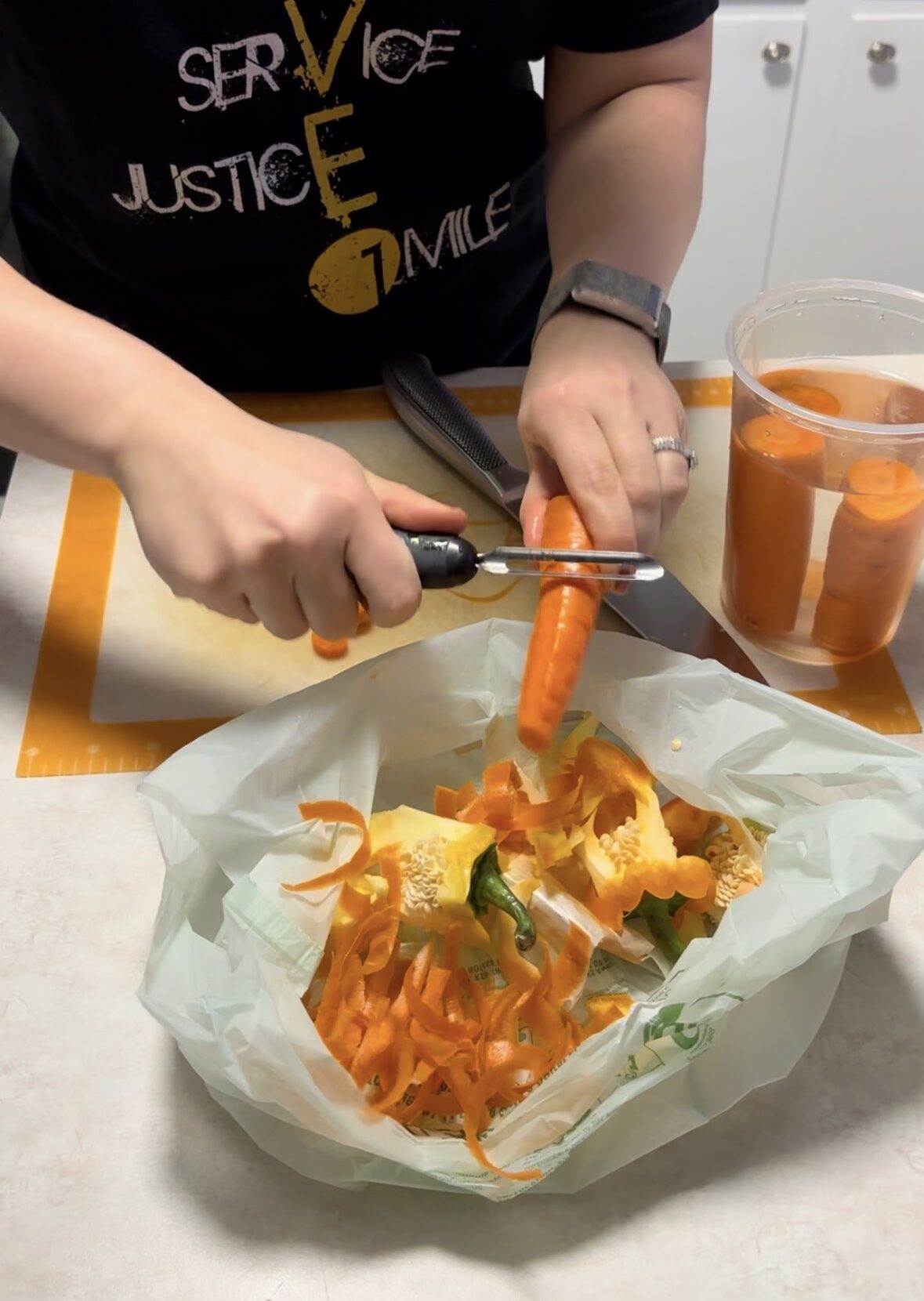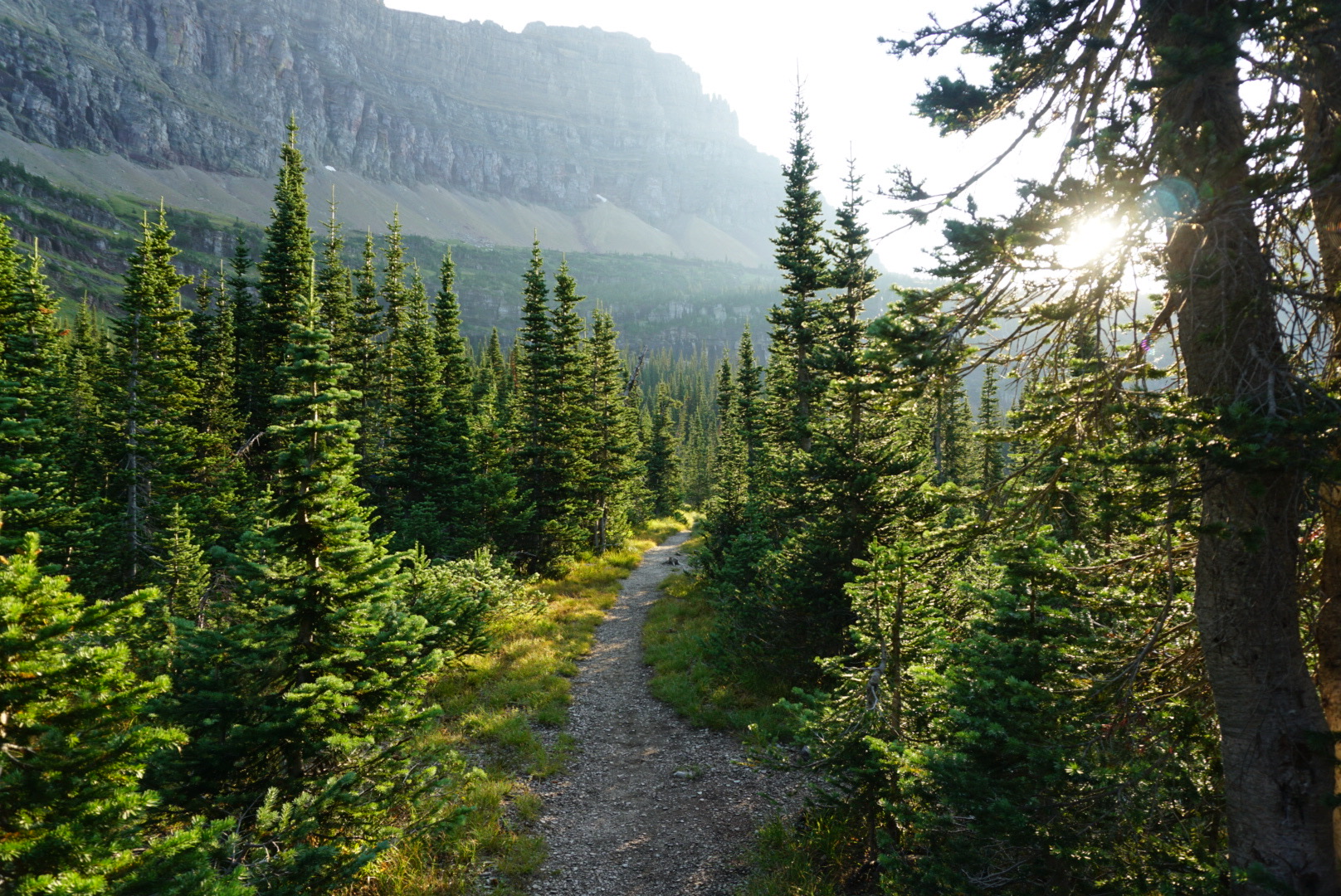From food scraps to organic produce
I have been composting my food scraps through a local drop off service for around six or seven years now. Since we bought our house a few years ago I have been wanting to start our own backyard compost and our own garden, but I haven’t quite made it a priority yet. Our neighbors across the street have both a backyard compost bin and a garden. It’s amazing how much food they produce organically! They vacuum seal and freeze a lot of their garden goods from the summer so they can use it throughout the rest of the year. We still travel a lot and haven’t spent enough time planning for our garden and compost. So for now, we still use a local drop off for our compost. I think it’s important to compost food scraps, which is why I am okay with paying for a local service. It makes the most sense for our lifestyle and priorities at this moment.
What is compost?
Compost is the result of the natural decomposition process of organic matter. You can combine food scraps like apple cores, the insides of a squash, or skins of potatoes as well as yard waste like grass clippings to expedite the decomposition process that happens naturally. Once the decomposition process is complete, you have “compost” which can be used as a fertilizer in gardening or farming. Compost is rich in nutrients like nitrogen, phosphorus, and potassium which plants require to grow. This is why compost is so valuable in the agricultural community! And isn’t it cool that our waste can turn into something so valuable?

Why is composting better than throwing food scraps away?
When I originally heard about composting, I didn’t understand how it worked. I didn’t understand how it was different from sending food scraps to a landfill. Here’s the deal: when you throw your food waste into an open area, it undergoes a natural aerobic (using oxygen) decomposition process. This process happens through microorganisms, which require oxygen. When you throw your food waste into a landfill, there’s so much other trash that the food waste will mostly not have access to oxygen. This forces an anaerobic decomposition process (without oxygen). The anaerobic process creates biogas as a byproduct. Biogas is primarily methane, but also includes some carbon dioxide. Both of these gases contribute to global warming and climate change.
We have taken a natural decomposition process that’s beneficial to the earth and turned it into production of greenhouse gases which is harmful to the earth. In fact, in the United States, landfills are the third-largest methane emitters due to food decomposition. Even though landfills have methods to reduce methane emissions, it’s impossible to capture all of them. Only about 6% of food scraps are composted in the United States.
Benefits of composting
The surface-level reasoning for supporting composting we have already covered, but let’s go through some other benefits of composting as well!
- Combats the food waste problem: approximately one-third of our food is disposed of in the United States. While I believe we should work to combat our food waste in other ways (store food properly, buy imperfect produce, etc.) composting can certainly help with this issue! There will always be food scraps that humans do not want to eat. Composting is a great way to reduce these residuals in a productive way.
- Saves money: we spend a lot of money to transport, treat, and store waste in the United States. When San Francisco established a compost program in 1996, within four years they were able to divert 50% of waste from landfills! There are certainly costs to operating a compost facility. However, the compost can be sold to farmers or gardeners to bring in the money needed to operate the facility.
- Creates healthier soil: Compost is rich in nutrients like nitrogen, phosphorus, and potassium, all of which help crops grow. Some more specific ways that compost creates healthier soil are…
- Compost improves soil’s water retention capacity. If the organic matter in soil increases by 1%, the soil can hold approximately 20,000 gallons more water per acre! Since composting increases soil organic matter, this is a great way to improve water retention. Having better water retention in the soil decreases the need to water crops. It also increases resilience to drought and increases crop yields.
- Compost improves nutrients in the soil. Monocropping is a typical practice in industrial farming which refers to producing the same crop(s) in the same field(s) year after year. Different crops require different nutrients to grow, so monocropping really depletes the soil of specific nutrients, which in turn make the food grown less nutritious. Farmers often choose sewage sludge and synthetic fertilizers to help replenish nutrients in the soil. However, as previously mentioned, compost is high in nutrients critical for crop growth. Rather than use alternative methods that often require more energy to produce, compost is a more natural way to spur growth. Many organic farming operations choose to use compost (in addition to manure) as their primary source of fertilizer to increase their yields and promote crop growth.
- Compost prevents erosion. Composting increases soil permeability. This allows more water to seep into the soil than flow over the soil. Water flowing over the soil is what causes erosion to happen. Composting also helps to bind soil together. This also prevents runoff and erosion from occurring.
- Combats greenhouse gas emissions: The methane generated from landfills due to food (organic waste) decomposing gets emitted to the atmosphere and is classified as a greenhouse gas. Composting prevents methane generation, and thus prevents greenhouse gas formation.
Pros and cons of composting
Here’s an example of the impact composting can have in the United States. Let’s say the US increases the ratio of compost to waste by just 8%. This study demonstrates carbon emissions will be reduced by 30 million tons per year! The change also leads to an economic benefit of composting. We would save about $16 billion in costs related to managing waste.
Composting does require some energy, especially when done on an industrial scale. At a high level, industrial composting emits only about 10% of the greenhouse gases that are emitted by landfills for the same quantity of food or other organic waste.
A potential concern with composting is nutrient pollution. That may sound confusing – aren’t nutrients a good thing? Well, in 2014 Massachusetts passed a law requiring composting for commercial quantities of food waste (greater than 1 ton per week). Due to the quick implementation of this law, the state of Massachusetts also relaxed some regulations for new compost facilities so there would be enough capacity to handle all the commercial waste. This led to “nutrient-rich leachate” from the composting process being discharged to local waterways.
While the composting law was very successful in reducing landfill waste, it was unsuccessful in the fact that it introduced a new pollutant to local water supplies. Nutrients are good – but too much of anything can be harmful. We want to keep the nutrients in the compost so it can be applied to the soil where we grow our food, rather than have it run off and contaminate local waterways. These issues can be resolved through proper design of composting facilities and wastewater treatment facilities.
Local compost programs are the easiest way to start
Hopefully I’ve now convinced you that composting has a lot of benefits! So how do you start composting?
Many cities and states now have commercial composting programs available. However, they may not be widespread depending on where you live. I personally live in Northeast Ohio and I choose to pay a subscription to Rust Belt Riders. If you live within a certain area, you can be part of their pick-up route. This is arguably the easiest because it’s similar to a trash pick-up. You leave your compost outside, someone picks it up, you refill the bin for the following week. I do not live within the pick-up area, so I pay for their drop off membership. This gives me access to their locked compost bins all over the city and suburbs. I can drop my compost off in many different locations which gives me flexibility to drop it off when I’m planning to be in the area.
Now if you have a bunch of food rotting while you’re waiting for your next drop off, it’s not going to smell good. I combat this by freezing my compost. I purchased these BPI certified compost bags. These are acceptable for commercial composting facilities like Rust Belt Riders, but they may not work in your home compost. All my compost goes into a bag and once it’s full, I tie it off and throw it in the freezer. This prevents the food from decomposing early and making my house stink!
It’s only about a 20-30 minute drive to the compost drop-off and I don’t find that the compost defrosts that quickly. It makes for an easy and stench-free drop-off. This subscription service is only $12 per month, which is worth it to me. We eat a ton of vegetables and fruits, so we always have food scraps. Additionally, because this is a commercial compost facility, they can also accept animal products (including meat, bones, and dairy) as well as oily foods. These items would attract unwanted animals to your home compost pile, but the commercial site is well set-up to manage these.
To find a compost facility near you, I’d first recommend searching a compost drop-off or pick-up sponsored by your city. If that doesn’t exist, you can check out this website where you can search for a local organization or farm looking to collect compost.

Composting at home: open air cold method
If you have interest in starting a compost of your own, there are a few different ways to do so. I’ll share some of the more common ways here, but feel free to do your own research as well to find what works best for you!
The first composting option requires little investment to initiate. It’s called open air composting, which can be classified as cold or hot depending on how it’s managed. Cold composting is easiest – the natural decomposition process happens on its own and it takes little effort to manage. However, the process takes a long time before you get finished compost to use (1-2 years). Additionally, depending on what you put in your compost pile, there may be lingering bacteria. The low temperature of the pile may not kill off all of the bacteria.
Composting at home: open air hot method
Hot composting is faster, but it takes more effort to manage. Hot composting requires the correct ratios of carbon, nitrogen, oxygen, and water to help the microorganisms break down the waste faster. Nitrogen comes from “greens” like food waste and grass clippings. Carbon comes from “browns” like paper, sawdust, dead leaves, and sticks. Ideally for hot composting the ratio will be approximately 2-4 to 1 (carbon to nitrogen). Oxygen is introduced by turning your compost pile to ensure it’s continuously exposed to air. There’s typically enough water in the compost pile just from food scraps, but additional water can be added from the environment (rain) or you can add water yourself if it’s too dry. The right consistency is often described as a “wrung-out sponge”.
The carbon and nitrogen feed the microorganisms, and the oxygen and water help the microorganisms breathe and digest. With the right ratios, your compost pile will likely maintain a temperature of 130-140 degrees fahrenheit which is high enough to kill any bacteria or parasites. With this method, your compost will likely be complete in about 12 months’ time. The smaller the pieces you add to your pile, the quicker the decomposition! Be sure to bury your food waste to not attract any pests.
Building your bin
To build your compost pile for the cold or hot process, you’ll need a container. You can build your own bin or use an old container or trash can. Make sure there are enough holes in the bottom and sides for drainage and airflow; however, the holes should not be large enough for any rodents or other animals to pass through. You’ll likely want a closed container to prevent animals from getting in. If you don’t have the space to build your own container-based compost pile, you can purchase a smaller compost tumbler unit. With the tumbler unit you’ll need to use the handle to tumble the waste daily or at least a few times per week to assist with airflow and decomposition.
How to use your compost effectively
Your compost needs to be mature to use in your yard or garden. At some point you will have to stop adding waste to your compost pile for your compost to fully mature. Mature compost looks like soil with no foul odor. If you used the hot composting process, the temperature of your mature compost should be similar to nearby soil, not significantly warmer. Once your compost is mature, you should let your compost sit another four weeks before use. It’s also recommended to sift your compost before use in case you missed any produce stickers or in case anything did not fully decompose.
Composting at home: worm method
If you have little to no space outside to maintain a compost bin or tumbler system, you could consider composting through worms indoors, also called vermicomposting. Worms digest food waste and release something called “castings” which contain the nutrients required for plant growth. This process completes in about 3-6 months, and you will have to harvest your compost once the process is complete.
You can purchase a vermicomposter or make one yourself. It requires a relatively small wooden or plastic container with a type of bedding like shredded paper or leaves and a way to drain out and catch the liquid generated through the process. Worms also require very specific conditions to survive. They will try to escape if they can, and they require a moderate temperature to survive. They should not consume animal products, dairy, citrus fruits, oils, or foods with a very strong odor like onions and garlic. Be sure to get the right type of worms for composting (red wrigglers are most common). You’ll typically need about 1 pound of worms for this process.
Ready to start composting?
One day I would love to have my own compost pile and vegetable garden!! My husband and I love to travel, and we both have full-time jobs in addition to our side gigs. Now’s not the right time for us to maintain our own compost pile and garden, but maybe one day. For now, I’m enjoying that I can still compost all of our food scraps through our local Rust Belt Riders industrial composting company. I can still save our food waste from the landfill, without the time it would take to create my own compost. Do you compost your food waste? Let me know what method you use in the comments below!
SOURCES:
- https://directcompostsolutions.com/8-methods-composting/
- https://www.nrdc.org/stories/composting-101#howto
- https://www.epa.gov/snep/composting-food-waste-keeping-good-thing-going#:~:text=In%20addition%2C%20composting%20lowers%20greenhouse,in%20the%20presence%20of%20oxygen.
- https://www.compostingcouncil.org/page/CompostBenefits
- https://www.epa.gov/recycle/composting-home
- https://www.ncbi.nlm.nih.gov/pmc/articles/PMC9575438/






